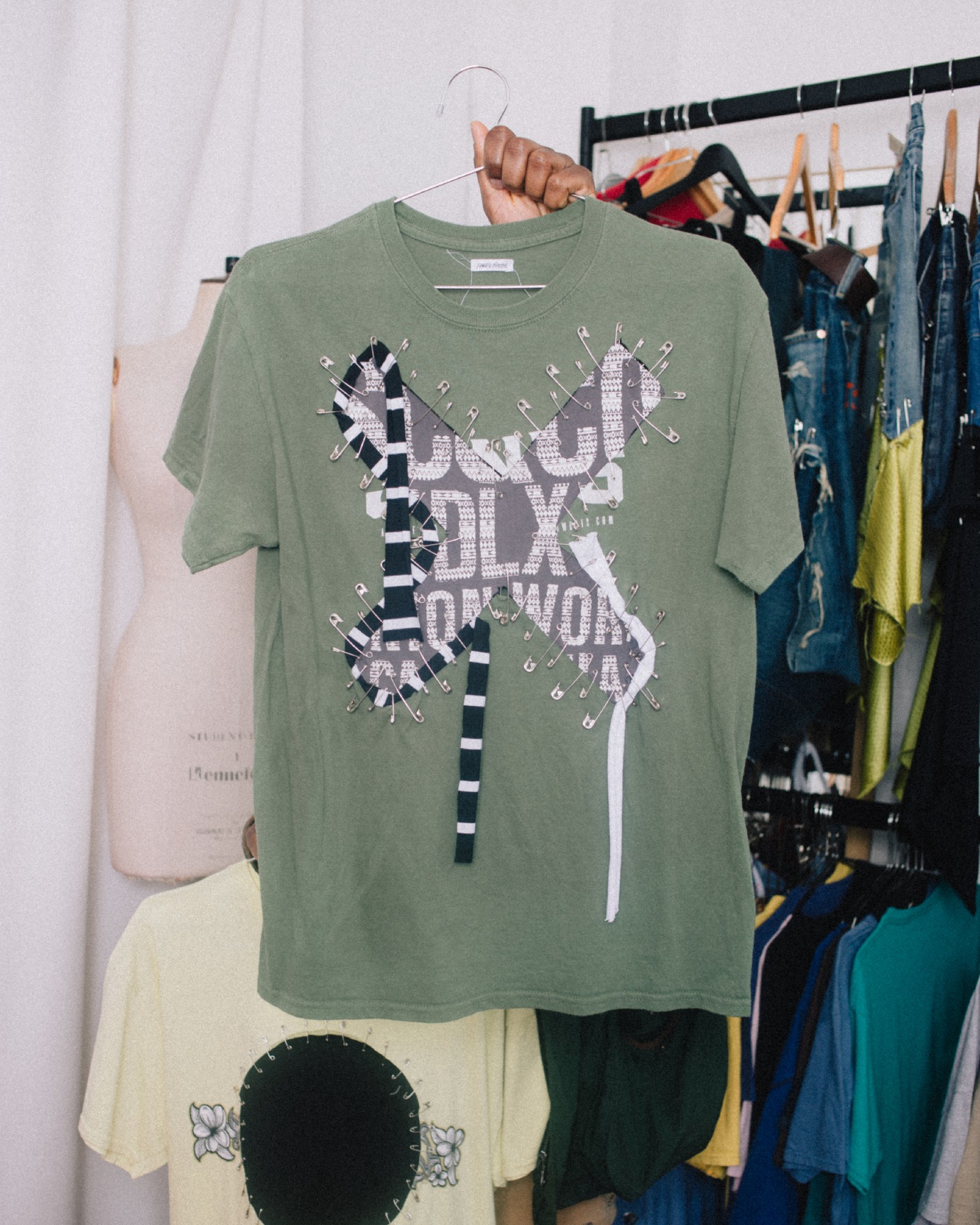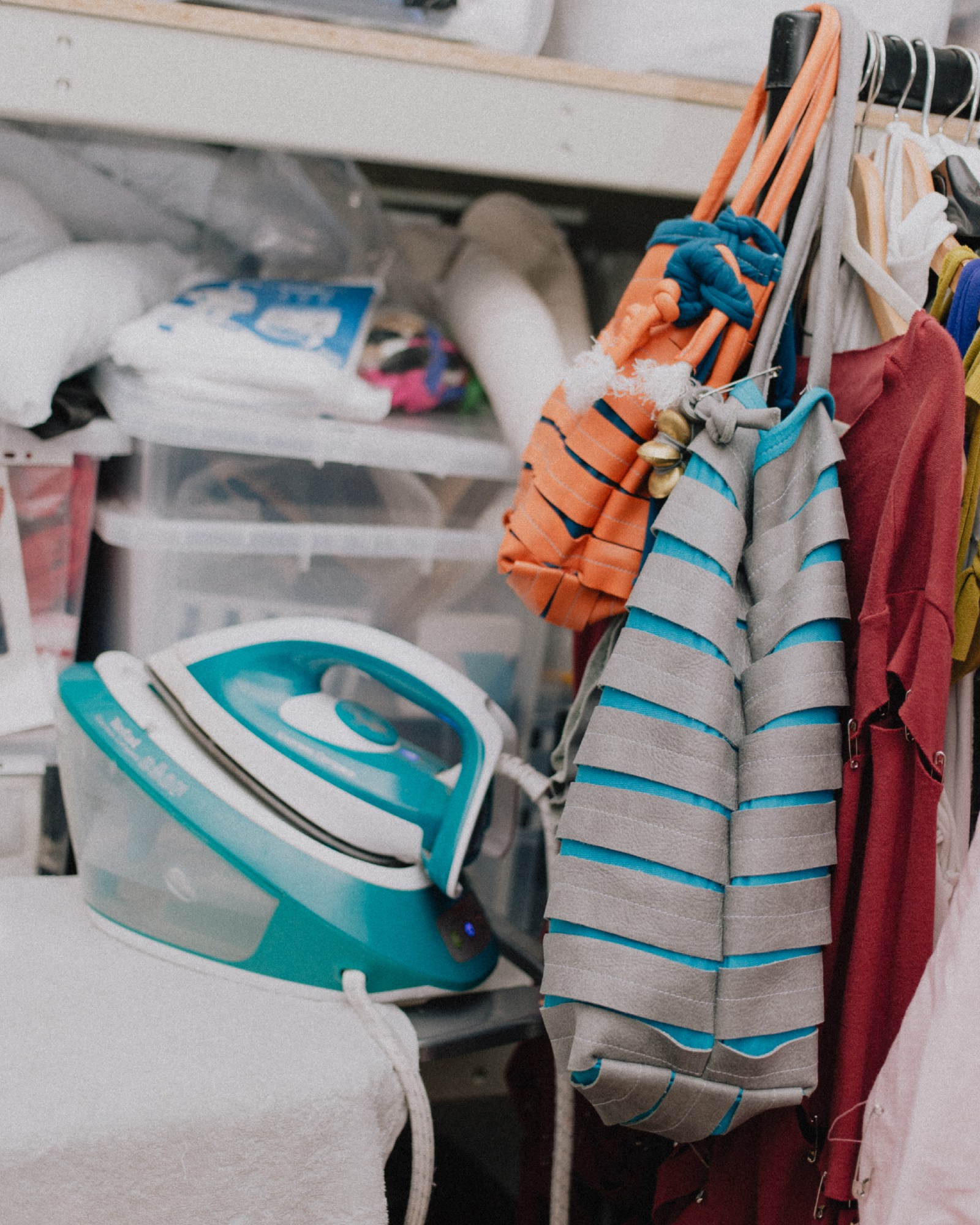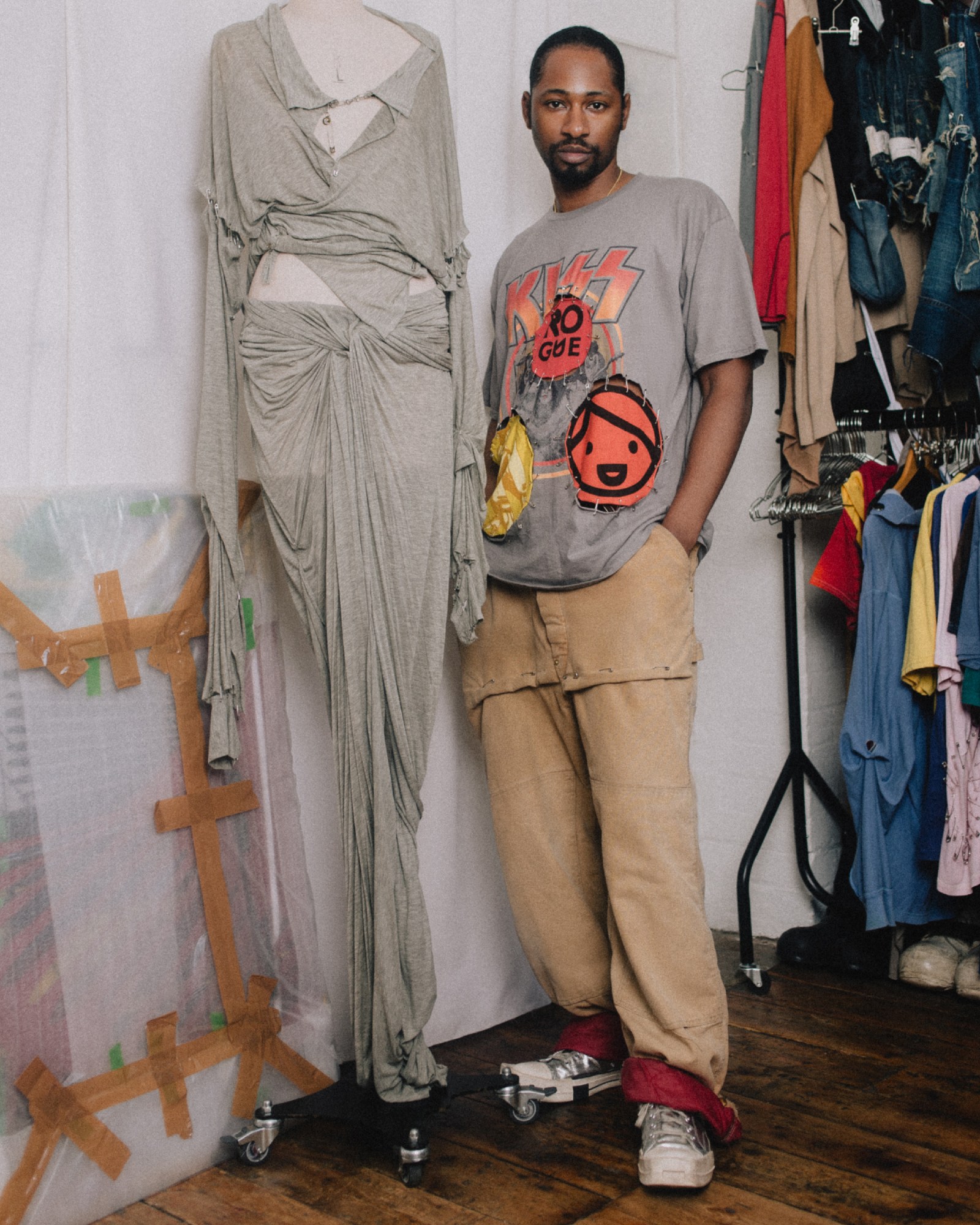Jawara Alleyne’s studio is one of those places where you instantly feel at home. Spread across two cosy rooms on the ground floor of a Victorian warehouse in Bethnal Green, spools of fabric nestle in corners, boxes explode with charger leads, trinkets adorn every surface, and runway imagery is tacked up all over the walls. The designer has been rooted here for seven years, over which time his warm energy seems to have suffused into the bricks themselves.
It’s a sunny morning, and I’m sitting in a space-age armchair Jawara upholstered himself using a lustrous red fabric he’s used to make “20 different things,” including a gown Anok Yai wore to the premiere of The Matrix Resurrections last year. Reclining in a desk chair opposite me, the designer is dressed in his daily uniform: a chopped and safety-pinned tee with skewiff, sand-coloured jeans. He wears his own designs most days. “The one thing I kind of appreciate about this space [being so small] is that it forces me to change it around,” he says. “You need to be able to be flexible.”
A sense of flexibility, of natural ease, is incidentally one of the things that makes Jawara’s brand so special. Honouring the human body in all shapes and sizes, his designs are made not merely for the runway, but to be worn in real life and feel powerful in. Working in daringly draped deadstock jersey fabrics, the designer tells the stories of the geographies that have shaped him. Each collection is a balancing act, merging the Rastafarian mysticism of his birthplace, Jamaica, the pirate folklore of the Cayman Islands, where he spent his teen years, and the subcultural spirit of London, which has been his playground since moving here aged 19 with dreams of becoming a designer.
“Having somebody like Rihanna genuinely say that I’m her favourite designer is so validating.”
Two seasons out of talent incubator Fashion East, the Central Saint Martins alum is happily taking things in his own direction. Jawara’s first standalone shows, both held in churches (“churches chose me,” he says), have confidently cemented his genre-blending perspective on Caribbean identity. At the 800-year-old St Mary le Strand church in central London in February, he took his love affair with drapery down complex new avenues, with skin-baring looks channelling the resilience needed to make it through hurricane season in the Caribbean. “Every year, somebody’s island gets completely destroyed,” he says. “You just have to live in this cycle of rebuilding.”
In 2024, Jawara’s personal resilience is keeping him afloat at a time when fashion has never felt more precarious. Alongside returning to Central Saint Martins as a lecturer, he’s launched a bespoke service called Untitled, bringing him closer to his core values of circularity and his brand’s community. The one-off service ranges from casual items to be worn every day – like crafty patchworked jumpers hewn from vintage knitwear, or surfer necklaces made from found stones – to more intricate made-to-order pieces crafted in close dialogue with his customers. New to Jawara’s cohort of devotees is Bajan superstar Rihanna, who’s not only been wearing his rebellious creations on repeat, but name-dropped him as her “new favourite designer” in a conversation with Interview magazine.
“I keep coming back to Rihanna,” Jawara says when asked about the proudest moment in his career so far. “I’m trying to define something that I feel like she expresses: being a person from the Caribbean who pulls in these feelings of reggae and punk. There were a lot of times over the years that I’ve been questioned for what I do, because they were not necessarily things that immediately sell. Having somebody like her genuinely say that I’m her favourite designer is so validating. It’s like, ‘Aha! You guys cannot question me anymore.’”
It’s a pinch-me moment Jawara’s younger self would have only dared dream of. Despite identifying as an introvert, he speaks about his life with an easy openness, shifting from memories of his childhood in Jamaica to subjects like mental health without hesitation. Raised in the happy clamour of his grandmother’s house with a mix of cousins, even as a kid he always needed alone time, often sequestering himself to scrawl glamorous figures into the pages of a sketchbook. “I grew up seeing my aunts and my mother being super fab, wearing incredible outfits,” he remembers. “I think having this image of these women who carried themselves with such confidence, I was always inspired by that. I unknowingly channelled that into my drawings.”
His father was a Rastafarian who he didn’t grow up around, though he felt just as connected to the religion as the Christian values of his mother’s side. “The energy is that you live on the land, and there’s a lot of discourses about vibrations,” he says. We start flipping through books from his well-stocked library, where swashbuckling histories mix with fashion tomes on Belgian designers like Martin Margiela. He plucks out a peeling monograph by Patrick Cariou, Yes Rasta, which gathers striking black-and-white images of Rastafarian men in the 90s, shot amid Jamaica’s lush natural landscapes. “That rawness kind of seeps into my work,” he says of the portraits.
So too has an ethos of circularity – a practice that isn’t a modern commercial ideal in the Rastafarian culture, but a way of life. “They’re a holistic community,” Jawara says. “They grow everything, they rework everything, they repurpose things. Nothing goes to waste. Those are the kind of value systems that they live by, and that’s also the way I try to approach circularity.” It’s the reason why salvaging materials, trawling charity shops and making treasure out of single-use T-shirts – worn and forgotten after charity events or hen dos – is a natural instinct for the designer, rather than the afterthought it might be for other brands.
“What I love about him is that he’s just so humble,” says Lulu Kennedy, who first met the designer at Notting Hill Carnival, later enlisting him into the Fashion East cohort in 2021. “When we first had a proper chat, he didn’t even really talk about his brand as sustainable. For so many people, that would be the first thing they would say. He was just like, ‘Oh yeah, of course. I could never use a ton of new fabrics and horrible, wasteful methods of working.’ He had his own aesthetic and energy from the jump, really. His energy is very relaxed and that translates to his clothes. I think his personality is his clothing.”
Beneath this gentleness, Jawara has a hardy inner self-belief – something he formed after relocating to Grand Cayman in his early teens, where he was othered by his peers at school. “I was clearly a queer kid; I didn’t look like them and I talked very differently, having come from a different place,” he remembers. It was during these years he set a laser focus on becoming a designer, completing a business degree to appease his mother before securing a spot on a dual marketing and design course at London College of Fashion. “There’s a lot about growing up in the islands [where] you were told about who you’re supposed to be,” he says of the move across the pond. “I almost needed to reject everything that I knew in order to discover myself again.”








Soaking up London like a sponge, Jawara finally found belonging among the city’s eclectic mash of young creatives. Mixing in the libraries of Central Saint Martins – where he would spend hours on fastidious research projects – he formed close bonds with contemporaries like stylist Ib Kamara, artist Rhea Dillon and photographer Campbell Addy, who he helped found Nii Agency with in 2016. “I always say this to my students, and I will always come back to this: The most important thing that you do in uni is everything that you do outside of uni,” the designer says, reflecting on that period of self-discovery. “I cannot preach that any more clearly.”
“We connected over our similar energies, economic backgrounds, beliefs and Caribbean desires,” Rhea says of Jawara. The pair have collaborated several times since meeting at CSM; notably, the multi-disciplinary artist gave him free reign on the costumes for her performance Catgut: The Opera at The Serpentine Gallery in 2021. Transforming the three orators into living sculptures, the designer created dramatic white ensembles which were partly inspired by Bob Marley’s backup trio, the I Threes voices. “He can make beauty out of anything,” says Dillon. “[Jawara] is community first. It creates a mutually personal energy to his making and being.”
Working against the stiff traditions of menswear during his MA, it was instrumental for him to shift to designing womenswear too. “His final runway with us was so triumphant,” Lulu says of his last collection at Fashion East – a skillful clash of modern yachting and historical pirate garb that was all about joy, dreaming and the coming together of community. “I always watch the front row and see how people are reacting to it. Everyone was smiling. It was just so fresh and easy, and he did this lovely finale walk with his brother Tafari, who he worked really closely with on the music. At that moment, I really felt everyone just saw Jawara. He was totally seen and understood.”
Lulu teamed him up with Marika-Ella Ames to style the show. “She’s brought all her femininity and love to [his clothes], you know,” Lulu says. “Jawara is incredible to work with,” the stylist says. “I think his collections are physical dissertations on an idea. Every piece has context. Every placement of a chiffon ‘sail’ panel layered onto a shirt or the directions and volume of every drape on a skirt are all symbolic to an overarching story. I think in Jawara’s DNA, amongst many other things, is fantasy and memory.”
Key to Jawara’s design language is a freeing approach to the body and bearing skin – something that is second nature in the Caribbean, the designer explains, simply due to the heat. “I think in London, people are not very confident in their bodies, which is weird because people are always going to the gym,” he jokes. “I think it’s like a situational thing. Summer here is very short, so you don’t actually have enough time to get comfortable.”
Though his clothes might be interpreted as sexy, the designer’s liberating shapes – where waistlines are slung super low, twisted tees are hacked to reveal midriffs and chiffon falls off the body in sail-like waves – are actually meant to relay a purer sensuality. “I just want people to feel confident,” he explains. “It’s not about trying to be erotic, it’s about being comfortable in your body.” It’s the reason he feels so connected to the second-skin feeling of jersey. “It’s the modern fabric,” he says. “It’s what we all wear on a daily basis.”
From the baseline of this democratic material, the humble tee, Jawara creates something complex and deep. Comfortable and beautiful, yet resolutely tough, his creations find the sticky friction points between opposites: the romance of mythology and the modernity of streetwear; the sunny vibrations of dancehall and the punk spirit of 70s King’s Road; the classic glamour of eveningwear and the spliced codes of deconstruction. His next show, coming up this month, will be at the heart of all of this. “It’s gonna be the best one yet,” he says with a smile. “It really is a statement about who I am, this point of view that comes from an island that makes somebody like Rihanna say that this is their favourite designer.”
Without giving too much away, the designer says the collection will be titled ‘Island Underground.’ “It’s kind of jumping out of Beach Business (SS24), when I was looking at underground streetwear culture in Cayman,” he says. “From there, I’ve kind of taken that forward. There’s a lightness that I want to come across in this collection, but a lightness that has a sense of complexity to it as well. I think a lot of what I’ve done previously kind of needs to come with an instruction manual. This collection still holds that chaotic energy and that excitement, but it’s also a little bit more approachable. Garments that feel easy to put on your body.”

One thing he’s excited to debut is a new venture into ‘graphic stories’, made alongside rising forces in the Caribbean creative scene. “In many ways, I’m asking what is underground? I’m inspired by new artists that are in that moment before you become successful, when you’re just working on passion,” he explains. “I’m also thinking a lot about the music in my show. I’m working with my brother, who is also sort of at the beginning of his music career. There’s something quite exciting about when you’re at that point where it’s all about just expressing – I think that’s kind of the mode that the brand itself has been in as well.”
That being said, the exhilarating rush of a runway isn’t what drives the introverted designer. “I keep saying this, but I’m gonna do two more shows, and then I’m not doing runways ever again,” he says. “I just want to do other things.” He points towards a rack of bespoke orders when I ask what the future holds. “I feel like these items are really special and precious. It also makes more sense in terms of sustainability. The ready-to-wear model is dying, it’s all crumbling, and the stores are closing. With everything I make, I know there’s one person out there that’s really gonna fucking love it – that, to me, is what’s exciting.”
Text: Orla Brennan
Photography: William E. Wright
